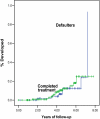Risk of developing disability in pre and post-multidrug therapy treatment among multibacillary leprosy: Agra MB Cohort study
- PMID: 22454186
- PMCID: PMC3330256
- DOI: 10.1136/bmjopen-2011-000361
Risk of developing disability in pre and post-multidrug therapy treatment among multibacillary leprosy: Agra MB Cohort study
Abstract
Objectives: If leprosy is a public health problem, it is due to the disabilities it causes. Surprisingly little is known about the risk of disabilities. Even now, mainly cross-sectional studies report disability prevalence. The present study aims to report the risk of disability in pre and post-WHO multidrug therapy (MDT) in multibacillary leprosy patients and to assess the extent of the incidence of disability.
Methods: The study design is prospective and the setting is an institutional field area. Patients were detected during 2001-6 field surveys. Of the 289 multibacillary patients, 146 completed the study. Both sexes were involved. The primary outcome planned was to study cure of disease, relapses and disability in patients receiving MDT. The secondary outcome was to measure reaction and default. Assessment was done clinically. Data have been analysed using SPSS software, logistic, survival analysis was performed and the χ(2) test of significance was used.
Results: An important risk factor was found to be three or more nerves involved with odds of 3.73 (1.24-11.2), and delay in treatment; 2.27 (1.04-4.96) at the pre-MDT stage and three or more nerves involved with odds of 2.81 (1.0-7.9) at the post-MDT stage. The incidence of disability was found to be 2.74/100 person-years; 2.69 in the MDT arm and 2.84 in defaulters, with slightly higher disability among early defaulters (3.08) than among late defaulters (2.30). The study suggests that the incidence of disability could be slightly higher if treatment is not completed.
Conclusion: Early treatment for leprosy is a must for reducing the risk of disability, and treatment delay would increase the risk of disability. It is important to note that the incidence of disability between defaulters and those completing treatment was not found to be significantly different.
Conflict of interest statement
Figures




References
-
- Ponnighaus IM, Boerrigter G, Fine PEM, et al. Disabilities in leprosy patients ascertained in a total population survey in Karonga District, Northern Malawi. Lep Rev 1990;61:366–74 - PubMed
-
- Selvaraj G, Prabhakar N, Muliyil J, et al. Incidence of disabilities among multibacillary cases after initiation of multidrug therapy and factors associated with the risk of developing disabilities. Ind J Lepr 1998;70(Suppl):11S–16S - PubMed
-
- Kumar A, Yadav VS, Girdhar A, et al. Some epidemiological observations on leprosy in Agra, India. Int J Lepr 2001;69:234–40 - PubMed
-
- Kumar A, Girdhar A, Girdhar BK. Epidemiology of leprosy in urban Agra, India. Lepr Rev 2003;74:31–4 - PubMed
-
- Kumar A, Girdhar A, Girdhar BK. Prevalence of leprosy in Agra district (U.P.) India during 2001–2003. Int J Lepr 2005;73:115–21 - PubMed
LinkOut - more resources
Full Text Sources
Molecular Biology Databases
Miscellaneous
